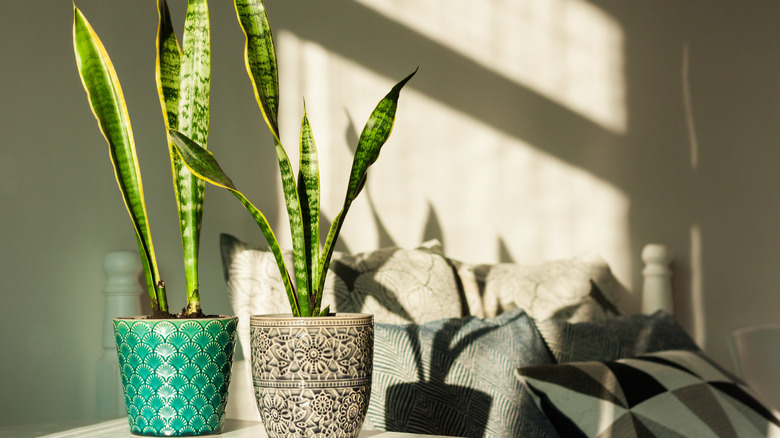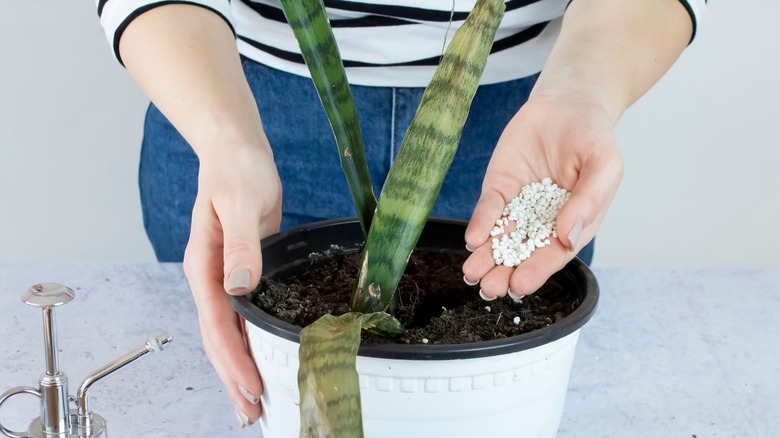Martha Stewart's Top Tips For Ensuring A Thriving Snake Plant After Dividing
Though an overall easy-to-maintain species, the snake plant (Sansevieria trifasciata) does need a bit of help to keep it thriving and growing for years. This succulent is a beautiful plant, noted for its long, pointed leaves that seem to be reaching for the sky. Often in various shades of green, this can be an excellent addition to your houseplants, and because you can divide it, it can be a plant you share, too. However, there are a few things you need to do to ensure your plant can continue to grow properly after dividing. Martha Stewart offers some foolproof tips.
Dividing snake plants, with their stunning sword-like shape and striped patterns, is a fantastic way to add beauty to multiple areas of your home. You can divide these houseplants rather easily by separating them into pieces that each contain all of the important components (the root system, steps leading upwards, and green leaves). Any time you are dividing a plant, you are creating stress on it, and that means it can become damaged or even diseased if not given the right environment and tools to thrive.
In an appearance on NBC's "Today," Stewart shared tips on how to care for various houseplants, the snake plant included. After explaining how to divide houseplants, she shared a step that makes a difference to their long-term growth: Make sure you fertilize them.
Give plants the nutrients they need to grow
The division process is taxing on all plants, as it requires them to work harder to grow and develop. Fertilizing the plants allows the roots to gain access to a large amount of nutrients that can help with the growth and development of new systems, including new roots, stems, and leaves. As Martha Stewart states, "If you eat, so should your plants."
Adding nutrients to the soil just after planting the divided portions is critical. Keep in mind that most houseplants pull these nutrients only when they are in an active growing phase. Since you want to stimulate growth at the time of dividing them, it's an excellent time to add in some nutrients. While fertilizer is good (and often necessary even with good soil for the new plants to grow in), you can have too much of a good thing. Too much fertilizer can create an environment with too much salt concentration. Over time, this can damage the plants by altering the soil microorganisms. In fact, too much fertilizer can actually stunt the growth of your roots.
At the same time, pay close attention to the signs of damage to the plant once established. For example, if the snake plant is turning yellow, that's an indication of too much water, which can also challenge the plant's growth.
What type of fertilizer is best?
Finding the right type of fertilizer for your snake plant is also important. Martha Stewart recommends Osmocote, which has small beads of coated nutrients. It has a blend of nitrogen, potassium, and phosphorus, the three key ingredients that most plants need to thrive. This is added to the soil once the plant is in place. Be sure to follow the manufacturer's instructions on how much to add to the plant and how often.
You can also choose a liquid version of fertilizer that has this balance. As a liquid, it is more readily available to the plant right from the start, which can help with the initial planting of divided parts. However, pellet-like fertilizers are a better option over time. As you water your plant, these small beads break down slowly, allowing the nutrients to mix gradually with the soil so the roots can use them.
For those looking for common household items that can be a natural fertilizer for the snake plant, head right to your kitchen. Composting egg shells and banana peels is one option. You can also create a houseplant soil with an equal blend of perlite, peat moss, and sand to help ensure good water drainage.


